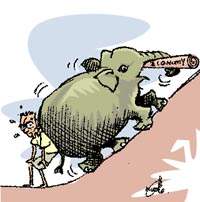| The Sunday Times Economic Analysis By the Economist | ||||||
|
Year of economic recovery and modest growth The
year that is passing away would be best described as one of economic
recovery and modest growth. The expected
economic recovery was seen mainly after the first half of the year.
In the first half of the year we achieved an economic growth of
only 1.4 per cent. The government expects an economic growth of
3 per cent for the entire year. This seemed a little unrealistic
in the light of the first half-year's economic performance. However, later
developments appear to indicate an enhanced growth momentum that
might ensure a 3 per cent growth. Considering
the fact that in 2001 the economy declined, the economic recovery
is most welcome, yet the economic growth is rather weak. Agricultural
production is likely to record a modest growth, although coconut
production fell by a substantial 15 per cent. Tea production, on
the other hand, is running at around 5 per cent more than last year.
It is most likely that tea production would achieve a new record
of over 305 million kilograms. Paddy production too revived. Rubber
production increased marginally. The revival
in industry was much less than expected. Industrial production increased
by less than 2 per cent in the first ten months of this year, though
the increase in imports of raw material and industrial capital equipment
indicated that industrial production was on the rise. The cessation
of hostilities gave rise to an expectation of a boom in tourism.
However, this did not materialise till the latter end of the year.
The first half of the year witnessed a drop in tourism. Even at
the end of September, tourist arrivals and earnings had declined
by 2 per cent. This has, however,
been off set by an increase in tourist arrivals in October. As a
result tourist earnings in the first ten months have been 5.9 per
cent higher than during last year's ten months. There are several
disappointing economic indicators. The weak economicperformance
is captured in the country's trade performance. Export earnings
were 6 per cent less in the first ten months of this year than in
the first ten months of last year. This was mainly
owing to a decline in industrial exports by 6.6 per cent. The industrial
export performance was much worse earlier on, when industrial export
earnings had declined by nearly 10 per cent. There is a justified
expectation that the final two months exports would improve the
year's overall export performance. At the end of October, the trade
deficit was running at US$ 1118 million, nearly 13 per cent higher
than in the corresponding period last year. This compares with a
trade deficit of US$1147 for the entire 2001. The trade deficit
is likely to edge to around US$ 1400 million by the end of the year. The enormity of the public debt was the focus of attention at the beginning of the year. It has soared higher. The public debt has continued to increase during the course of the year. It was about 16 per cent higher at the end of October than a year before. This 16 per
cent increase implies that the per capita burden has increased still
further. The public debt of Rs 1615 billion converted to per capita
terms is around Rs. 80,000 per person. As we look back at the economic performance of the year, we certainly cannot be satisfied with the modest gains made during the year. The cessation of hostilities may have prevented the sliding of the economy further, but the gains from the hitherto attained peace have been limited. This underscores the theme this column has plugged many times during the year, that peace is a necessary condition, yet not a sufficient one. We cannot achieve rapid economic development through peace alone. |
||||||
Copyright © 2001 Wijeya Newspapers
Ltd. All rights reserved. |
 At its
beginning there were greater expectations that the global recovery
and the cessation of hostilities would usher in a more spectacular
growth. This has not been realised.
At its
beginning there were greater expectations that the global recovery
and the cessation of hostilities would usher in a more spectacular
growth. This has not been realised.